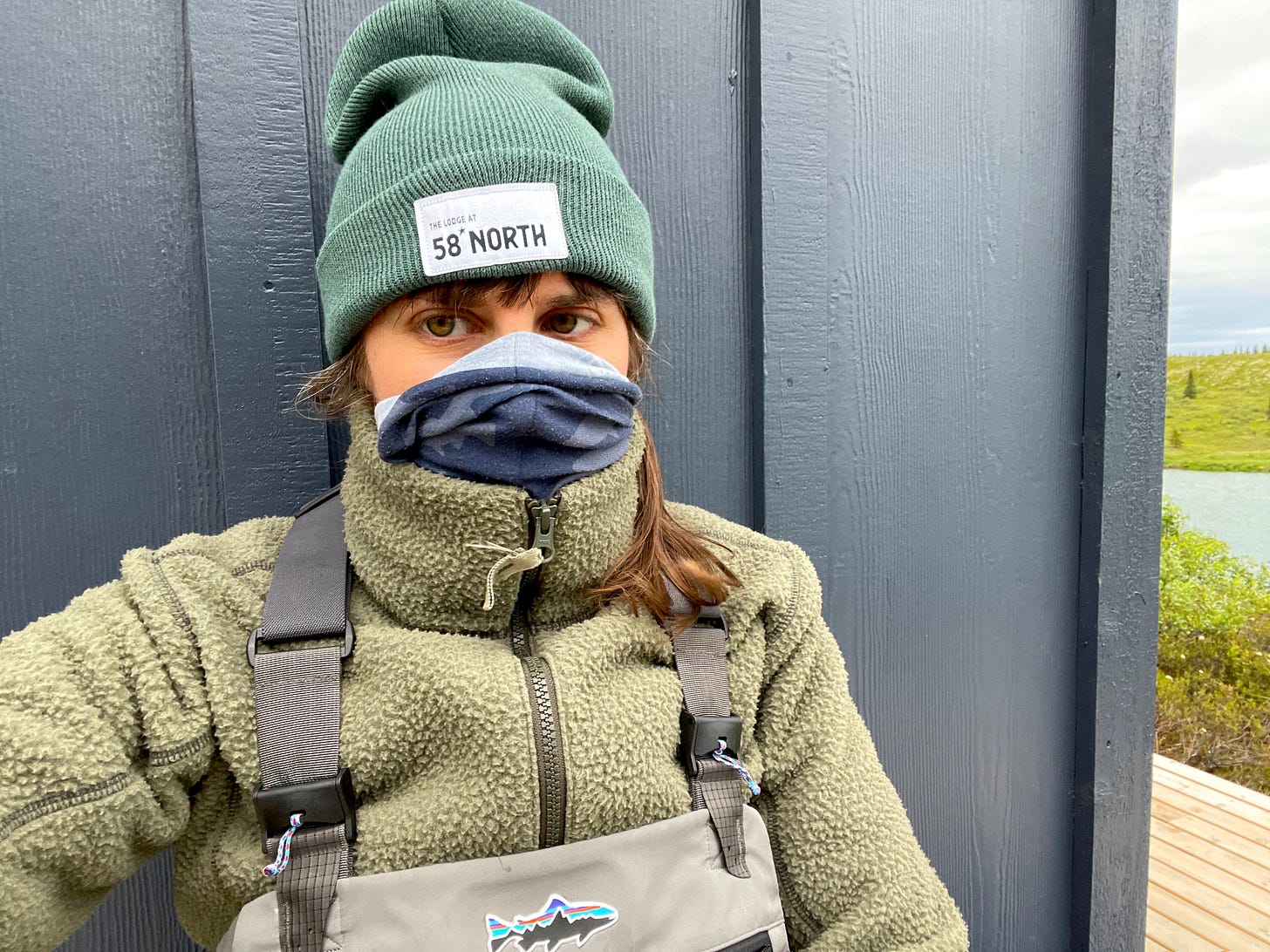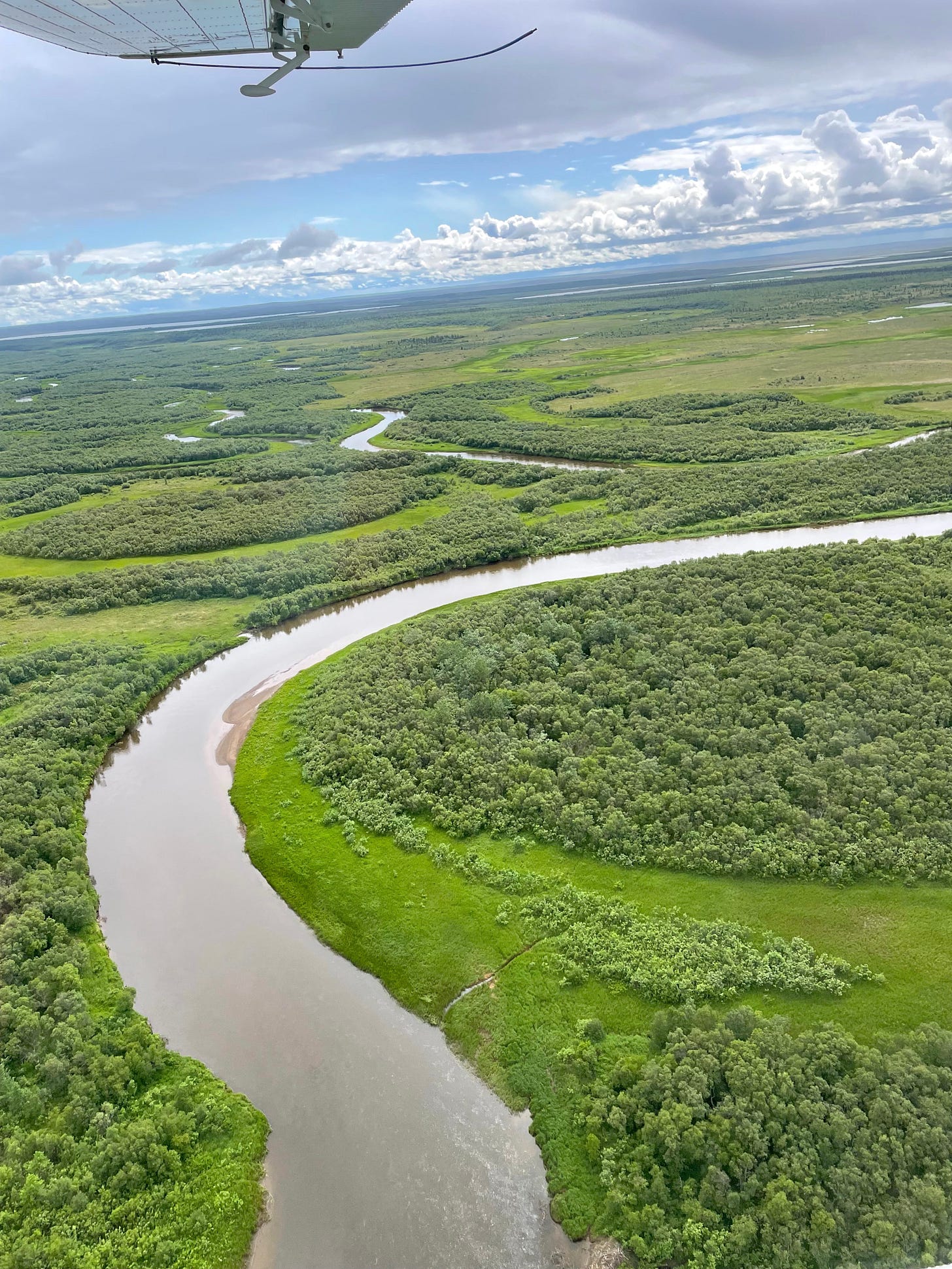I would make a terrible grizzly bear
That time I "fished" among the apex predators at Katmai National Park
I didn’t read the itinerary closely enough on the day I visited Katmai National Park & Preserve in southern Alaska. In hindsight I’m not sure if I’d have wanted to know that I’d be fishing in the very same river as the grizzly bears.
I was on day three of a week-long dunking in an immersion tank of adventure with the Lodge at 58 North, an all-in fishing and adventure lodge in King Salmon, Alaska. I’d been invited to accompany a group from United Women on the Fly—a platform that connects and empowers women who fly fish—who were also the most insatiable, impressive anglers I’d ever met. Before this trip, I had fished maybe half a dozen times.
Each morning, I’d clamber into my ill-fitting waders and layer on every shirt and fleece I’d packed. (PSA: Summer in Alaska is not very warm.) We’d board a little float plane that deposited us at some of the most remote and breathtaking locations I’d ever seen, where we’d spend the day fishing for chinook and sockeye salmon, speckled rainbow trout and iridescent arctic grayling. All day long, my companions cast into clear, cold rivers with fluid, powerful action like a coiled python striking its prey—forever chasing the adrenaline of the next catch. They nerded out on bait types and lure weights with inside-baseball verbiage I could barely understand. Occasionally they didn’t want to break for lunch because they wanted to keep fishing instead.
I, on the other hand, constantly sought small ways to put off fishing—taking a really long time to finish my sandwich and find places to pee. I’d stand on the edge of the boat for long stretches, pretending to scan for clusters of salmon swimming upstream like little ghosts. When we found quiet rivers I would skip stones, unaware that this might scare away stationary fish. (Did you know they’ll just stay still sometimes? I didn’t.)
I dawdled partly because I wasn’t very good at fishing. But mostly I preferred standing in the cold, surging water and taking it all in, a temporary accessory to this extraordinary landscape where the seasons unfold and the creatures endure with tangible drama and urgency.
Katmai hadn’t been the original plan on the day we went, but we rerouted there because of high winds. The landscape of this remote park, which is only accessible by plane or boat, spans tundra, forests, lakes, mountains and a huge valley of lava flow and ash formed by a catastrophic eruption a century ago. It’s one of the last places on earth to witness the annual wild salmon run — the miraculous phenomenon in which millions of fish swim back from the ocean to spawn in freshwater. It’s also home to roughly 2,000 brown bears. You’ve probably seen the iconic still shot of a bear catching a salmon in its mouth atop a rushing waterfall; that was almost definitely taken at Katmai’s Brooks Falls. (You can watch the bears all day long here. It’s magnetic.)
The most astonishing fact about this park, however, is that not only do you wander the very same paths as the grizzlies, you can also fish in the same water if you have a license.
National parks are some of the most risk-averse places I’ve ever visited, so I believe when they say this is safe. But come on, I’ve seen “Grizzly Man!” I’ve also seen “Jurassic Park,” specifically the scene when the goat is lowered into the forest to bait a starving, genetically engineered T. Rex.
Thankfully, our initial interactions were perched a safe distance away on the floating viewing platform. Brooks Falls stood empty; the salmon were late this year, we learned. Suddenly, a two- or three-year-old bear emerged from the trees and made his way to the falls. He snorkeled for a few minutes before galloping downstream in frustration. He swiped fruitlessly at the water a few times before perching on a rock to survey the river.
“C’mon,” I said aloud. “Get one!”
Just then an older, much burlier bear emerged directly beneath my feet. He plodded down the path with what I can only describe as hungover swagger. His lightish brown fur was matted in parts like he’d slept on it funny. I pictured him partying all night, probably trashing his hotel room. He crashed through some tall grass and heaved up onto his hind legs to scratch his back on a tree trunk. He stuck out a paw to anchor himself on another thick branch, which promptly broke off. He watched with what looked like mild amusement before setting off again along the shore.
Suddenly, bam! — he swiped that big old paw into the river and pulled out a salmon. Just like that. The young bear looked on with a desperate sort of anguish from his boulder perch. I’ve never felt sorrier for another creature.
“Don’t worry,” Lodge at 58 North co-owner and longtime fishing guide Kate Crump told me. “He’ll be gorging himself in a few weeks.”
She went on to describe this sort of bell curve of bear feeding that coincides with the crush of salmon that fight their way through here to spawn. When the bears first make their way out of hibernation, they’re weak and hungry. A pecking order develops at the falls, with the baddest-bitch bears, like 2022’s #fatbearweek winner 747 (aka Bear Force One) claiming the choicest fishing spots, where salmon fling themselves into their waiting maws. At the run’s peak in July, the bears are gorging themselves like it’s an all-you-can-eat-buffet on a Caribbean cruise. They even get picky, throwing smaller fish back or only eating the brains and bellies before casting the rest aside like two-day-old chowder. But the salmon aren’t done providing; their nutrient-rich remains feed other wildlife and leech into the soil providing compost for the diverse plant life that springs up around the river. As the salmon dwindle come fall, the bears again grow desperate as they prepare to hibernate.
On the way back to the trail, we briefly glimpsed the fat bear champ himself, the scar-marked 747, lumbering through the trees. At a mere 900 pounds, he was apparently a shadow of his fattened-up 1,400-pound self, which resembles a furry, blimp-sized water balloon about to burst.
“Where are we fishing today?” I asked our guide, Ryan Burge. He gestured toward the same path I’d just watched 747 amble across, which led to the same river from which that other, hungover bear had mindlessly plucked a salmon.
“What?”
“Yo, bear!” called my other companion, cheerfully deploying our sole defense against these apex predators. “I wish I’d brought my bear spray!”
Every rustling leaf and cracking twig on that agonizing little hike made me jump. By the time we reached the river, I was in full flight or fight mode, casting anxious glances up and down the shoreline as we waded into the thigh-deep water. A short way off at the falls, five or six bears were fishing now, too. I recalled how fast that young bear had sprinted through the water.
“OK so you guys know you can’t keep fishing if you see a bear,” said Burge. He sounded irritated at the prospect of missing fish.
“Because they think we’re competing for their food source!” I shrieked, standing my fly rod straight up like a white flag in the ground.
“You can be our lookout since it doesn’t look like you’re planning to fish,” he replied. “And remind me to tell you later about the time I charged a bear.”
From time to time, photographers would appear at the water’s edge to snap our pictures with their telephoto lenses. After all, we were yet another awe-inspiring feature of this wild place, which people would see and gasp, “Who on earth would fish in the same river as grizzlies?” On reflection I enjoy thinking about the photos of me, standing there rigid with fear.
At one point, a photographer quickly disassembled his lens and broke into a jog downstream; a bear was rustling around somewhere behind him.
“We’re not the ones in charge here, eh?” he joked, to which I laughed a little too maniacally in reply. The bear emerged from the brush moments later, probably 150 feet from where I stood.
“Yo bear,” I half-whispered, my hands in the air like it was a stickup. “They’re all yours, the fish.”
“The thing is, they’re so uninterested in us,” Crump later told me. Indeed, we paltry humans matter so little in these giants’ ruthless annual struggle to survive. We come to gaze idly as they jostle for places in the lethal soap opera of Brooks Falls. But I like to imagine we may provide them with occasional, mild amusement in turn, like turning on reality TV.
As Crump so eloquently put it: “Maybe they feel sorry for you.”
I pictured the bears glimpsing me with my total lack of fishing instincts and layer upon layer of ill-fitting clothing. Some threat. I’m almost relieved they didn’t see that time I tangled my lure so badly it resembled a dreamcatcher.
“Look at her with all that stuff on, and that flimsy stick with a string!” one bear snickers. “Where are her claws? And those pathetic little fangs! She’ll never catch a thing!”
Another swipes a pawful of popcorn. “Oh, I don’t know. I hope she gets one. I don’t think I’ve ever felt sorrier for another creature.”








Marge, I adore this recap of our day dancing and fishing with grizzlies! Also being able to look back on our week through non-fish obsessed/addicted eyes gives a whole new perspective. I mean, why would I want to eat lunch when I could possibly have met another grayling instead?? I loved being immersed for a week with you, and I hope to adventure with you again soon! Even with Bear 747! 💕
Love this! I can picture you standing, frozen, fishing pole in hand!